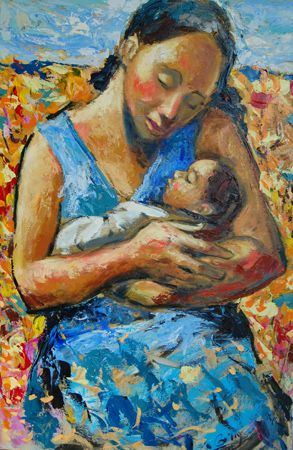
by Lee Ann M. Pomrenke
The people sitting near us were so concerned. My 3-year-old daughter started weeping during one of the somber Lenten hymns, and did not stop until after it was over. Still mostly non-verbal at that point, I doubt she understood the words, yet she felt the music and its mournfulness deeply. Years later, she gravitates towards scary books or movies, I suspect for the strong emotions they evoke. I too have felt tears prick my eyes and run down my cheeks within seconds of glimpsing an abstract painting by Emmanuel Sierra, which now hangs in our living room. We each yearn to feel, even if the emotion is sad or angry, and experiencing artwork may open the floodgates to connect with our inner life.
Art has a power to move us in ways that intellectual knowledge or physical action cannot do. Music, stories, performance and visual art somehow manage to connect us with feelings buried deep inside ourselves, or in empathy with others beyond us. I cannot imagine something more life-giving than that. Amidst the epidemics of depression and loneliness that characterize our time, art that gives us access to our own inner life and solidarity with others may just save us. If Christians indeed want to bring hope into the world and more abundant life to all God’s children, then we will invest in art.
Art does not have to be “religious” to do this holy work. Whatever content comprises a work of art, it can deepen our empathy for those who think or live differently from ourselves, and prompt self-realizations about how we interact with our world. This is theology: faith seeking understanding (according to Anselm of Canterbury). To be part of the crowd moving together to any kind of music or spoken word may re-attach us to the larger family of humanity God created us to be. It may move us to not only feel, but to act on that kinship. Protest art, like the holy family separated by cages or signs at a rally stir up our passionate responses, reminding us of who we are, and what is important to us. They may also pull us away from despair at our isolation. It is faithful to do many other things beyond creating or appreciating art, of course. We need to press our representatives to work for just policies, to protect human rights and value the dignity of all people. We need to work: providing accessible health care, helping children to receive quality education, and growing healthy food. But for those gifted with the capacities to develop into artists, we must support their efforts so that we all can not only eat, but thrive.
Art can spur action, but engaging with art is also a tangible way to combat isolation and depression. Theater literally saves the lives of teens desperate for a social group, and keeps them attending high school. An elderly church member I visited recently has read so many books that she has a secret system of marking library books so her daughter knows not to check out the ones she’s already read from the library. Books written with great imagination save us from loneliness and keep our minds and hearts expanding. It is not frivolous escapism to find what makes your heart race and passionately invest in it, alongside a commitment to engage with your neighbors. The secular cultural message that “Christmas is about family” makes those who are already isolated or estranged feel even less valued and more alone this time of year. We should certainly feel our emotions, for it is part of our humanity. Yet for art of any kind to also give the lonely a taste of beauty and through it hope, is life-saving.
Advent is a wonderful time to seek out a renewed sense of wonder through performance art, visual arts, and even folk arts. Reach for a feeling beyond nostalgia, and attend an event from another cultural tradition other than your own, to hear the story from a fresh perspective. Participate in a concert your would not usually gravitate towards, or an additional worship service you do not think is your style. Surprising us is the part of awe which the Holy Spirit specializes in. Perhaps you too will take a cue from the children, who believe everyone is capable of making art that others will love, and do so freely. At one of the myriad seasonal bazaars, appreciate the handiwork of artists, but then look the artists themselves in the eye and ask about their work, their process, their inspiration. God is at work through them, and the art between them and our hearts. No canvas is too small, for God to speak to us through it. Perhaps it is a refrain, a dancer’s subtle movement or a note card of particular beauty that touches an emotion and reverberates within us so much so, that we want to tell someone else about it. Or support them by purchasing an artistic creation or recording. Tis the season when we want to give presents to many who have all they need. So why not give artwork, to inspire them in ways they did not know that they needed, but perhaps the Holy Spirit did?
Perhaps the upcoming relatively shorter church seasons of Christmas, Epiphany and Lent are also an invitation to bring the arts into a congregation’s life in new ways, or to give special offerings to support arts initiatives. Public art events or projects such as Los Posadas, mosaics or murals take beautiful imagery to the streets. To tell the old, old story in new ways may bless even those well-steeped in Christian traditions.
Lee Ann M. Pomrenke is a Lutheran pastor and writer in St. Paul, Minnesota. Her first book Embodied: Clergy Women and the Solidarity of a Mothering God is forthcoming from Church Publishing, Inc. in fall 2020.
image: Emmanuel Garibay ~ Woman with Baby (Blue Dress)

